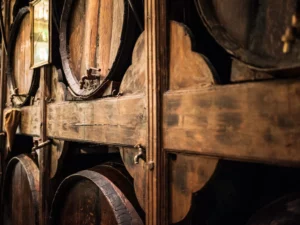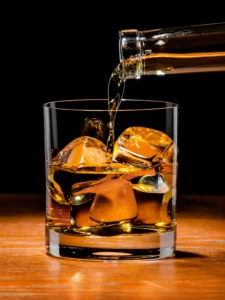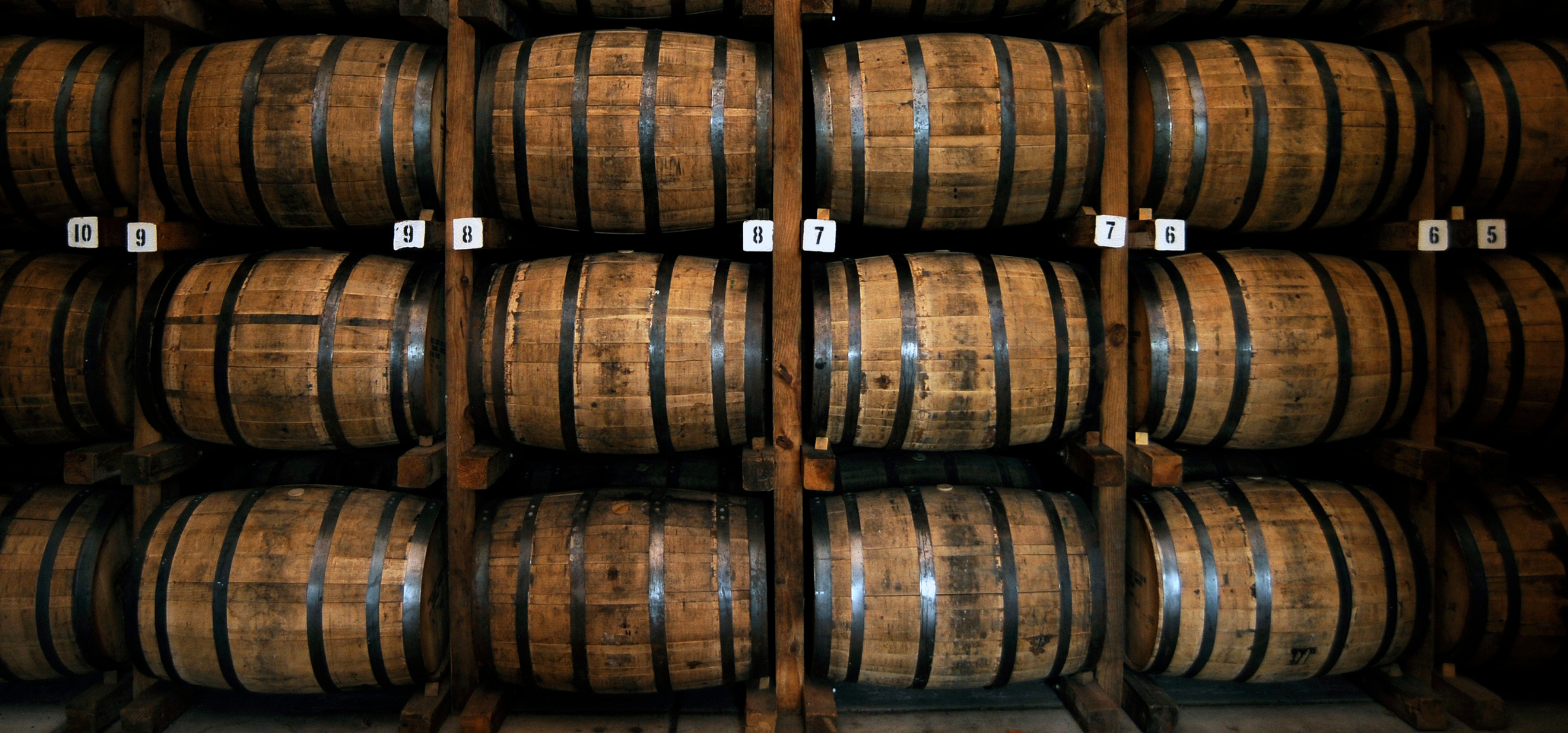Did you know some Oregon distilleries use ex-pinot noir casks to enhance local whiskey?
If you walk down the warehouse aisles of a winery or distillery, you will likely be flanked by oak barrels filled with wine or whiskey, stacked in neat rows. They may appear identical, however, if you ask, you will most likely find the wine in French Oak and the whiskey in American Oak. Recently, more and more of these French Oak barrels have been quietly making their way from the rolling vineyards to distillers and whiskey makers in one region of the Pacific Northwest.
Whiskey production is growing in Oregon. Twenty years ago, there were just two craft distillers in Oregon and today there are over 60, with many of them offering bourbon or American straight whiskey. This growth parallels a boom in the whiskey market country-wide, which, according to Statista, is projected to grow by 5.40% each year over the next five years.
This growth makes it an exciting time for Oregon whiskey makers, but also poses a challenge to distinguish themselves in an expanding national market. Oregon whiskey doesn’t have the colorful histories of some states like Kentucky and Tennessee that have been distilling for hundreds of years. The region is full of talented and creative distillers but does not yet have any flavor profiles or distilling styles that represent it. However, there is a burgeoning practice among makers in Oregon that may be changing that.
“As a craft distiller, I saw barrel finishing as an amazing opportunity to differentiate ourselves and present unique flavor profiles…Fortunately, I have a lot of wine-maker friends that were happy to help me experiment with French oak and the myriad expressions of Oregon’s number one varietal: pinot noir,” said Lee Medoff, head distiller and founder of Bull Run Distilling Company.
 Pinot Noir is a grape variety known for producing wine with complex notes of bright red fruits like raspberry and cherry, spice, as well as earthy tones. It is also notoriously difficult to grow. The Willamette Valley in Oregon, though, has both the climate and soil to help this fickle fruit thrive and has created a name for itself over the last 50 years as a producer of exceptional wine.
Pinot Noir is a grape variety known for producing wine with complex notes of bright red fruits like raspberry and cherry, spice, as well as earthy tones. It is also notoriously difficult to grow. The Willamette Valley in Oregon, though, has both the climate and soil to help this fickle fruit thrive and has created a name for itself over the last 50 years as a producer of exceptional wine.
In 2021 the Willamette Valley was formally recognized by the European Union and given Protected Geographical Indication (PGI) Status approval. PGI status affirms the quality of wine from this region and ensures that only wines produced in this region bear the label of “Willamette Valley” wines. Napa Valley is the only other wine region in the United States that carries this distinction.
Medoff told me he was inspired to finish in Pinot Noir barrels after a release of bourbon finished in Chinato Vermouth barrels sourced from a local winery sold out at record speed. That made an impression on Medoff and led him to wonder what he could do with finishing barrels used for a wine that was emblematic of the region.
“We source barrels from Tequila, Cognac, Madeira, Sherry, and other varietals in French oak and more, but the Pinot Noir Finish Whiskey is the only spirit specifically designated as coming from Oregon. I saw this as a chance to bridge two dynamic home-grown industries and maybe even give Oregon its own signature whiskey.”
Medoff isn’t the only one leveraging the established and reputable Willamette Valley pinot noir to create a name for Oregon whiskey. The Portland-based distillery Westward Whiskey features a pinot noir finished American single malt as one of its flagship offerings. Westward describes this as “a twist on tradition to honor the American Northwest.” In 2021, The Westward American Single Malt Pinot Noir Cask was awarded the double gold distinction at the San Francisco World Spirits Competition.
Women-owned and led Freeland Spirits in Portland also offers a bourbon finished in pinot noir barrels from Elk Cove to an “element of Pacific Northwest terroir”. The company’s master distiller, Molly Troupe, stated that the distillery’s proximity to freshly dumped pinot noir barrels “was an opportunity I could not pass up.”
Double Circle Spirits, which distills in Portland and grows all their wheat used in vodkas and whiskeys in Oregon on the Columbia Plateau, ran a limited release of a pinot noir finished bourbon that has since sold out. Jason Johnson, the founder of Double Circle Spirits, used to work in the wine business and was inspired to bring those two worlds together.
Oregon on the Columbia Plateau, ran a limited release of a pinot noir finished bourbon that has since sold out. Jason Johnson, the founder of Double Circle Spirits, used to work in the wine business and was inspired to bring those two worlds together.
Because they distill their own bourbon instead of sourcing it from elsewhere, it may be a few years before they are able to release their next batch, but after seeing how quickly they sold out, Johnson thinks it will be worth the wait.
“I thought about taking it [off the website], but we get a lot of conversation about it and people are interested in it. So, I just keep it up,” says Johnson.
The success of established distilleries releasing pinot noir finished whiskey is paving the way for newcomers to pick up the torch.
Chad Martinson has been a long-time believer in Willamette Valley pinot noir. He currently serves on the board of directors for Domaine Serene, an award-winning winery in the Dundee Hills of the Valley, and is working on another project behind the scenes.
He let me know that he will also be CEO of a new company that exclusively finishes whiskey in Domaine Serene pinot noir barrels, using MGP as base stock. He couldn’t tell me the new company’s name yet because copyrighting is still in the works. Martinson sees finishing in this way as necessary for creating a local whiskey identity:
“I think it’s very important for the region and whiskey because some of the best pinot noir comes from the Pacific Northwest, specifically Oregon…I think it will represent the region very, well.”
His initial release will feature two bourbons and a blended bourbon. They are slated to be released in late fall of 2023, either end of Q3 or early Q4. Martinson believes this project will appeal to whiskey and wine drinkers alike, “there are connoisseurs who are seeking an experience, and the experience [of drinking this whiskey] certainly can cross over between fine wine and fine whiskey.”
Utilizing these barrels may be a way to bring together an established industry in Oregon like winemaking with the newer but steadily growing whiskey industry. As Lee Medoff puts it, “it’s a chance to create and collaborate and discover what a rooted sense of place will offer.” What does finishing it in pinot noir barrels add to the taste though?
Medoff suggests finishing in pinot noir barrels (which are generally made with French oak barrels as opposed to whiskey barrels which are almost always American oak) adds softer vanilla undertones as well as notes of chocolate and coffee. However, he says the greatest contribution is a dryer mouthfeel, which he attributes to the tighter grains of the French oak and tannins coming from the pinot noir.
 Johnson also brought up mouthfeel when asked about what pinot noir barrels offer. He’s noticed this one has a silky texture that’s added after finishing. When exhibiting at farmer’s markets, he’s noticed the pinot noir finished whiskey often stands out because of the pink tinge this aging imparts to the liquid.
Johnson also brought up mouthfeel when asked about what pinot noir barrels offer. He’s noticed this one has a silky texture that’s added after finishing. When exhibiting at farmer’s markets, he’s noticed the pinot noir finished whiskey often stands out because of the pink tinge this aging imparts to the liquid.
Martinson notes that in his experience what pinot noir barrels add can vary depending on the barrel or edition of wine. However, in general, he states this finishing practice will often add notes of tobacco, leather, and deep, ripe red fruits.
Troupe also comments on red fruit notes, however, she gets specific and names cherry and stone fruit in particular.
No two whiskeys are identical, even if they share a similar finishing process
Below are my notes for two of Oregon’s pinot noir finished whiskey’s.
Bull Run Distilling Company Pinot Noir Finished American Whiskey:
It’s color is a dark red-brown that becomes a red-tinged amber when poured into a glass and held up to the light. Pear, apricot, and vanilla take the forefront of the nose. Vanilla custard and red currant mingle intriguingly with tobacco and wood spice. The mouthfeel is incredibly smooth. The vanilla stays through the finish warming cinnamon.
Westward Whiskey Pinot Noir Cask:
The liquid is a reddish brown, though lighter than the Bull Run one that becomes dark pink when held up to the light. The nose has cinnamon, anise, tobacco and ripe raspberry. The palate opens up to milk chocolate and baking spice. Grassy notes are sweetened by plum. The mouthfeel is smooth and silky without being too heavy or oily. The finish is pleasant with the spice and hay notes lingering.

